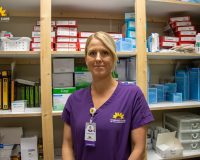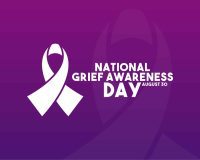On a crisp Saturday morning, Helen pulls up to a modest brick home in a northern NJ neighborhood. She sees the living room curtain pull back for a moment and knows she’s being watched by Allen, Jeannie’s husband. Ever since Jeannie became her patient, Allen would keep watch by the window on days Helen was scheduled to come, peeking through the curtains as the hour drew near. By the time Helen walked up to the front door, Allen was already opening it, greeting her with a hardy “Good morning!” as he stepped aside to let her in.
Married for 56 years, Allen had been taking care of Jeannie as her health and mobility declined after her cancer returned for the third time, now, spread throughout her body. Upon receiving the news, Jeannie decided to forgo further chemotherapy treatments. She had had enough and with nothing further that could be done medically, she wanted her remaining time spent in her own home surrounded by the life she and Allen created together. Both Jeannie and Allen had watched family members die in hospitals and knew that wasn’t where either one of them wanted to spend their last days, so when Jeannie told Allen her wishes, he completely understood.
Since Jeannie decided to forgo further treatment and her doctor estimated that she had less than 6 months to live, he told her she was eligible for hospice care, which is when they met Helen. A hospice nurse for the past 12 years and a registered nurse for over 20, Helen loves what she does. She comes in a few days a week and checks Jeannie’s vitals and records everything in her medical chart.
“Many people think hospice is only for people who are dying,” she said, “but it was actually started as a way for terminally ill patients to live without pain. There’s a definite emotional toll it can take but there’s so much that I receive in exchange. In fact,” she added after a moment, “I find it to be the most gratifying and creative work I’ve ever done. It’s been rewarding to see patients be able to live out their last days and complete their lives in more comfortable and familiar surroundings than the added fear and unfamiliarity of a hospital room or facility.”
To Jeannie, hospice has provided the exact end of life care that she was looking for and it eased Allen’s heart and mind as well because he could be with her all the time. Having someone else to talk with about Jeannie’s health and give advice on what he could do to make her more comfortable, makes him feel less helpless and gives them both a sense of peace and calm for the coming days.
After recording Jeannie’s vital signs and ensuring she wasn’t in additional pain, Helen checked in with Allan. It was just as important for Helen to see how he was holding up and whether there were any concerns he had or whether he felt he needed any additional support or counseling, until she saw him next. “I’m okay for now,” he assured her, “but don’t stop asking!”
“I don’t know how I could have done all this without Helen and the other hospice volunteers,” he said, unabashedly wiping a tear from his eye. They chatted for a bit longer until Helen needed to leave to go see her next patient. Helen left them with Allen sitting next to Jeannie who was lying in her hospital bed, holding her hand as they listened to music together on the radio.
Given the aging U.S. population and its need for eventual hospice care, most in demand for this care will be in long-term facilities that treat patients who have suffered strokes, head injuries, and long-term diseases. For patients like Jeannie, who choose to remain at home, hospice nurses offer a support system to both the patients and their families, providing space for the families to spend quality time together in casual surroundings and without the worry of intrusive machines or unfamiliar rooms.
Hospice also provides a respite for caregiver burnout. In addition to hospice nurses, there are also non-medical hospices and volunteers in which patients don’t receive medical care but instead receive assistance around the house, transportation, and basic companionship. Patients can elect to choose medical hospice from a Medicare-certified hospice as Jeannie has done.
The U.S. Bureau of Labor Statistics (BLS), counts hospice providers as part of the health care and social assistance sector and of all industry sectors BLS studies, hospice is projected to have the fastest employment growth and to add the largest number of jobs between 2012 and 2022. Several occupations employed by hospice providers such as personal care aides, home health aides, medical secretaries, physical therapists, occupational therapists, healthcare social workers, licensed practical and licensed vocational nurses, medical and health services managers, nursing assistants, and registered nurses are projected to add many jobs, grow quickly, and have a multitude of job openings.
For many, these are not just job titles but a support system that cares for patients and their families and gives them every opportunity to provide quality care and quality end of life care.




